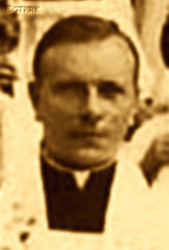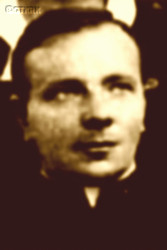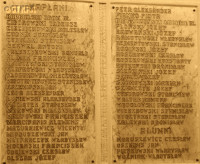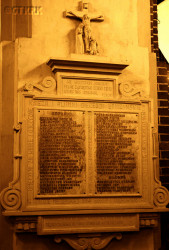Roman Catholic
St Sigismund parish
05-507 Słomczyn
85 Wiślana Str.
Konstancin deanery
Warsaw archdiocese, Poland
full list:
displayClick to display full list

searchClick to search full list by categories
wyświetlKliknij by wyświetlić pełną listę po polsku

szukajKliknij by przeszukać listę wg kategorii po polsku

Martyrology of the clergy — Poland
XX century (1914 – 1989)
personal data
surname
MACIĄTEK
forename(s)
Stanislav Paul (pl. Stanisław Paweł)
forename(s)
versions/aliases
Peter (pl. Piotr)
function
diocesan priest
creed
Latin (Roman Catholic) Church RCmore on
en.wikipedia.org
[access: 2014.09.21]
congregation
Society of Jesus SImore on
en.wikipedia.org
[access: 2014.09.21]
(i.e. Jesuits)
diocese / province
Łomża diocesemore on
www.kuria.lomza.pl
[access: 2012.11.23]
Płock diocesemore on
en.wikipedia.org
[access: 2013.05.19]
Polish Province SI (1918‐1926)
Galicia Province SI (till 1918)
RC Military Ordinariate of Polandmore on
en.wikipedia.org
[access: 2014.12.20]
honorary titles
„Cross of Valour”more on
en.wikipedia.org
[access: 2019.04.16]
(c. 1943, prob., posthumously, awarded by the commander of the Białystok District of the Home Army_AK)
date and place
of death
27.06.1940

KL Sachsenhausenconcentration camp
today: Sachsenhausen‐Oranienburg, Oberhavel dist., Brandenburg state, Germany
more on
en.wikipedia.org
[access: 2018.11.18]
details of death
After German and Russian invasion of Poland in 09.1939 and start of the World War II, after start of German occupation arrested for the first time in 10.1939 by the Germans.
Jailed in Suwałki prison.
Released on 11.11.1939.
Prob. collaborated with the emerging Polish resistance movement, under the pseudonym „Pustelnik” (Eng. „Hermit”) — posthumously recognized by the National Armed Forces NZS as its military chaplain.
Arrested again by the Germans in 03.1940 and again taken to Suwałki prison but soon released under condition of leaving his parish.
Went to Mikaszówka parish.
There finally arrested by the Germans on 06/07.04.1940 — together with local parish priest, Fr Stanislav Konstantynowicz.
Jailed in Suwałki prison.
From there on 17.04.1940 transported to KL Soldau concentration camp.
Finally on 03.05.1940 brought to KL Sachsenhausen concentration camp.
Initiallhy held in the so‐called „quarantine”. Then transferred to the Germ. Häftlingsblock (Eng. barrack) No. 40.
There perished.
According to the death certificate in the books of the Germ. Standesamt (Eng. registry office) in Oranienburg, No. 3141/40, the „honest” otherwise German „medical doctors” and formalists — and at the same time, unrivaled fairy tale spinners — noted that the cause of death was Germ. „Rechtsseitige Lungenentzündung” (Eng. „Right–sided pneumonia”).
prisoner camp's numbers
23604Click to display source page (KL SachsenhausenClick to display the description)
cause of death
extermination: exhaustion and starvation
perpetrators
Germans
sites and events
KL SachsenhausenClick to display the description, KL SoldauClick to display the description, SuwałkiClick to display the description, 04.1940 arrests (Gumbinnen region)Click to display the description, «Intelligenzaktion»Click to display the description, Ribbentrop‐MolotovClick to display the description, Pius XI's encyclicalsClick to display the description
date and place
of birth
11.12.1889Birth certification on:
metryki.genealodzy.pl
[access: 2025.09.05]

Siennicatoday: Nasielsk gm., Nowy Dwór Mazowiecki pov., Masovia voiv., Poland
more on
en.wikipedia.org
[access: 2022.01.28]
parents
MACIĄTEK John
🞲 ?, ? — 🕆 ?, ?

BRZEZIŃSKA Eleonor
🞲 ?, ? — 🕆 ?, ?
baptism
12.12.1889Birth certification on:
metryki.genealodzy.pl
[access: 2025.09.05]

Nasielsktoday: Nasielsk gm., Nowy Dwór Mazowiecki pov., Masovia voiv., Poland
more on
en.wikipedia.org
[access: 2021.12.18]
St Adalbert the Bishop and Martyr RC church
presbyter (holy orders)
ordination
08.02.1920

Stara Wieśtoday: Brzozów gm., Brzozów pov., Subcarpathia voiv., Poland
more on
en.wikipedia.org
[access: 2021.12.18]
positions held
1937 – 1940
parish priest — Wiżajnytoday: Wiżajny gm., Suwałki pov., Podlaskie voiv., Poland
more on
en.wikipedia.org
[access: 2022.01.28] ⋄ St Therese the Virgin RC parish ⋄ Suwałkitoday: Suwałki city pov., Podlaskie voiv., Poland
more on
en.wikipedia.org
[access: 2021.12.18] RC deanery
1934 – c. 1937
parish priest — Mikaszówkatoday: Płaska gm., Augustów pov., Podlaskie voiv., Poland
more on
en.wikipedia.org
[access: 2022.07.19] ⋄ St Mary Magdalene RC parish ⋄ Teolintoday: part of Sapotskin, Sapotskin ssov., Grodno dist., Grodno reg., Belarus
more on
en.wikipedia.org
[access: 2020.11.27] RC deanery
1932 – c. 1934
vicar — Bargłów Kościelnytoday: Bargłów Kościelny gm., Augustów pov., Podlaskie voiv., Poland
more on
en.wikipedia.org
[access: 2022.01.10] ⋄ Exaltation of the Holy Cross RC parish ⋄ Augustówtoday: Augustów urban gm., Augustów pov., Podlaskie voiv., Poland
more on
en.wikipedia.org
[access: 2021.08.06] RC deanery
1931 – c. 1932
vicar — Suwałkitoday: Suwałki city pov., Podlaskie voiv., Poland
more on
en.wikipedia.org
[access: 2021.12.18] ⋄ St Alexander the Pope and Martyr RC parish ⋄ Suwałkitoday: Suwałki city pov., Podlaskie voiv., Poland
more on
en.wikipedia.org
[access: 2021.12.18] RC deanery
1930 – c. 1931
vicar — Mały Płocktoday: Mały Płock gm., Kolno pov., Podlaskie voiv., Poland
more on
en.wikipedia.org
[access: 2022.07.16] ⋄ Exaltation of the Holy Cross RC parish ⋄ Kolnotoday: Kolno urban gm., Kolno pov., Podlaskie voiv., Poland
more on
pl.wikipedia.org
[access: 2021.12.18] RC deanery
1928 – c. 1930
vicar — Kobylintoday: Kobylin‐Borzymy, Kobylin‐Borzymy gm., Wysokie Mazowieckie pov., Podlaskie voiv., Poland
more on
en.wikipedia.org
[access: 2022.01.28] ⋄ St Stanislav the Bishop and Martyr RC parish ⋄ Sokołytoday: Sokoły gm., Wysokie Mazowieckie pov., Podlaskie voiv., Poland
more on
en.wikipedia.org
[access: 2021.08.06] RC deanery
1925 – c. 1928
vicar — Czerwintoday: Czerwin gm., Ostrołęka pov., Masovia voiv., Poland
more on
en.wikipedia.org
[access: 2021.08.06] ⋄ Holy Trinity RC church ⋄ St Michael the Archangel RC parish ⋄ Ostrołękatoday: Ostrołęka city pov., Masovia voiv., Poland
more on
en.wikipedia.org
[access: 2021.08.06] RC deanery
vicar — Baranowotoday: Baranowo gm., Ostrołęka pov., Masovia voiv., Poland
more on
en.wikipedia.org
[access: 2021.12.18] ⋄ St Bartholomew the Apostle RC parish ⋄ Przasnysztoday: Przasnysz urban gm., Przasnysz pov., Masovia voiv., Poland
more on
en.wikipedia.org
[access: 2021.12.18] RC deanery
vicar — Płocktoday: Płock city pov., Masovia voiv., Poland
more on
en.wikipedia.org
[access: 2021.12.18] ⋄ St Bartholomew the Apostle RC parish (main parish) ⋄ Płocktoday: Płock city pov., Masovia voiv., Poland
more on
en.wikipedia.org
[access: 2021.12.18] RC deanery
1923
leaving — Jesuits SI
friar — Krakówtoday: Kraków city pov., Lesser Poland voiv., Poland
more on
en.wikipedia.org
[access: 2021.06.07] ⋄ monastery, Jesuits SI
till 1920
student — Stara Wieśtoday: Brzozów gm., Brzozów pov., Subcarpathia voiv., Poland
more on
en.wikipedia.org
[access: 2021.12.18] ⋄ theology, Assumption of the Blessed Virgin Mary College, Jesuits SI
student — Dziedzicetoday: neighborhood in Czechowice‐Dziedzice, Czechowice‐Dziedzice gm., Bielsko‐Biała pov., Silesia voiv., Poland
more on
pl.wikipedia.org
[access: 2021.12.19] ⋄ theology, St Joseph monastery (Retreat House), Jesuits SI
student — Krakówtoday: Kraków city pov., Lesser Poland voiv., Poland
more on
en.wikipedia.org
[access: 2021.06.07] ⋄ philosophy, College (Lat. Collegium Maximum SS. Cordis Iesu, 26 Kopernik Str.), Jesuits SI
till 1913
friar — Bunkovychin .Khyriv
today: Khyriv urban hrom., Sambir rai., Lviv obl., Ukraine
more on
uk.wikipedia.org
[access: 2022.11.09] ⋄ monastery, St Joseph College („Khyriv” Scientific and Educational Institute), Jesuits SI — completion of secondary school education
1907 – 1908
novitiate — Stara Wieśtoday: Brzozów gm., Brzozów pov., Subcarpathia voiv., Poland
more on
en.wikipedia.org
[access: 2021.12.18] ⋄ Assumption of the Blessed Virgin Mary monastery, Jesuits SI
21.09.1907
accession — Jesuits SI
1906 – 1907
student — Płocktoday: Płock city pov., Masovia voiv., Poland
more on
en.wikipedia.org
[access: 2021.12.18] ⋄ philosophy and theology, Theological Seminary
author of novellas, short stories (i.a. under the pseudonym Jan Czar) — e.g. „The bells are ringing”, Łomża 1937; „The history of women”, Katowice 1935; „Wanda Malczewska”, Warsaw 1934; „Into the Father's hands”, Warsaw 1929; „The program of the poor”, Czerwin 1925; „Marshal Piłsudski at supper”; author of volumes of poetry — e.g. „Let's cut, let's cut beautiful roses”, Katowice 1932; „My soul loves the Lord”, Płock 1923; author of theological and literary articles in „Catholic Review”; collaborator of 8 issues of the magazine „Apostolate of the Prayer”; 1922‐1923 editor of „Sacred Heart of Jesus Calendar”; translator from French and Italian — e.g. „The Bride of Christ”, Kraków 1924
others related
in death
CYBULSKIClick to display biography Stanislav, KONSTANTYNOWICZClick to display biography Stanislav Peter, MALINOWSKIClick to display biography Francis, MŁYNARCZYKClick to display biography Vladislav, NARUSZEWICZClick to display biography Ceslav Leo, ŚLEDZIŃSKIClick to display biography Joseph Marian, WIERZBOWSKIClick to display biography Stanislav, WOŹNIAKClick to display biography Vladislav
sites and events
descriptions
KL Sachsenhausen: In Germ. Konzentrationslager (Eng. concentration camp) KL Sachsenhausen, set up in the former Olympic village in 07.1936, hundreds of Polish priests were held in 1940, before being transported to KL Dachau. Some of them perished in KL Sachsenhausen. Murderous medical experiments on prisoners were carried out in the camp. In 1942‐1944 c. 140 prisoners slaved at manufacturing false British pounds, passports, visas, stamps and other documents. Other prisoners also had to do slave work, for Heinkel aircraft manufacturer, AEG and Siemens among others. On average c. 50,000 prisoners were held at any time. Altogether more than 200,000 inmates were in jailed in KL Sachsenhausen and its branched, out of which tens of thousands perished. Prior to Russian arrival mass evacuation was ordered by the Germans and c. 80,000 prisoners were marched west in so‐called „death marches” to other camps, i.e. KL Mauthausen‐Gusen and KL Bergen‐Belsen. The camp got liberated on 22.04.1945. After end of armed hostilities Germans set up there secret camp for German prisoners and „suspicious” Russian soldiers. (more on: en.wikipedia.orgClick to attempt to display webpage
[access: 2018.11.18])
KL Soldau: German Germ. Konzentrationslager (Eng. concentration camp) KL Soldau (in modern Działdowo city) — since the pre‐war Polish Działdowo county was incorporated into Germ. Regierungsbezirk Allenstein (Eng. Olsztyn regency) the camp was located in occupied territories where general German law was in force, i.e. in Germany proper — was founded in 09.1939, when in former barracks of 32nd Infantry Regiment of Polish Army Germans set up a temporary camp for POW captured during September 1939 campaign. In autumn 1939 was also used as police jail. In 1939‐1940 changed into Germ. Durchgangslager für polnische Zivilgefangene (Eng. Transit Camp for Polish Civilians), prior to transport to other concentration camps. In reality it was used then as a place of extermination of Polish intelligentsia within Germ. «Intelligenzaktion» genocidal program and extermination of sick and disabled within «Aktion T4» program. Next in 05.1940 the camp was changed again into Germ. Arbeitserziehungslager (Eng. Work Education Camp), and finally into penal comp for criminal and political prisoners, most of whom were sentenced to death. In 1939‐1941 Germans imprisoned, maltreated and tortured in KL Soldau hundreds of Polish priests and religious. Approx. 80 priests, religious and nuns perished. They were murdered in the camp itself, by a shot into a head, or in places of mass executions in nearby forests — Białuty forest, Malinowo forets, Komorniki. Dates and precise locations of these murders remain unknown. Altogether in KL Soldau approx. 15,000 prisoners were murdered, including thousands victims — patients of psychiatric institutions (within «Aktion T4» plan). (more on: mazowsze.hist.plClick to attempt to display webpage
[access: 2013.08.17], en.wikipedia.orgClick to attempt to display webpage
[access: 2018.09.02])
Suwałki: Prison and detention centre run by Germans. (more on: www.slady.ipn.gov.plClick to attempt to display webpage
[access: 2013.10.05])
04.1940 arrests (Gumbinnen region): In the first decade of 04.1940 Germans as part of Polish intelligentsia arrests program arrested dozens of Catholic priests from parishes of occupied Suwałki region, incorporated into Regierungsbezirk Gumbinnen, an occupied region belonging to German East Prussia province. All were held in Suwałki prison and next transported to KL Soldau concentration camp. Few perished in KL Soldau, more later on in other concentration camp, mainly in KL Dachau. (more on: rospuda.euClick to attempt to display webpage
[access: 2016.03.14])
«Intelligenzaktion»: German: «Intelligenzaktion» (English: „Intelligence Action”) — a German program of extermination of the Polish elite, mainly the intelligentsia and leadership layers, carried out from the beginning of the occupation in w 09.1939 to 04.1940, mainly in territories directly annexed to Germany, but also in the so‐called Germ. Generalgouvernement (Eng. General Governorate), where it was called «AB‐aktion». In the first phase, immediately after the beginning of the German occupation, during military operations carried out by the Germ. Wehrmacht (Eng. Armed Forces) and the genocidal units of the Germ. Einsatzgruppen (Eng. Operational Groups) of the Germ. Sicherheitspolizei (Eng. Security Police), i.e. SiPo, and Germ. Sicherheitsdienst des Reichsführers SS (Eng. Security Service of the Reichsführer SS), i.e. SD, organized by the Germ. Reichssicherheitshauptamt (Eng. Reich Main Security Office), i.e. RSHA, which followed the troops, carried out under the Germ. Unternehmen „Tannenberg” (Eng. Operation „Tannenberg”) — based on the so‐called Germ. Sonderfahndungsliste (Eng. Special Wanted Lists), i.e. proscription lists of Poles considered particularly dangerous to the Third Reich, prepared by the Zentralstelle II/P (Polen) unit of the German RSHA. Later, implemented by the German civilian occupation authorities and the genocidal unit of the Germ. Volksdeutscher Selbstschutz (Eng. Ethnic Germans Self‐Defense), whose members were Germ. Volksdeutsche (Eng. Ethnic Germans), i.e. representatives of the German minority in Poland. According to various sources, these lists, at the beginning of 09.1939, could have contained the details of 61,000—88,000 „dangerous” Poles — although these figures cannot be confirmed. In total, during this genocide, c. 50,000 teachers, Catholic priests, representatives of the landed gentry, freelancers, social and political activists, and retired military personnel were systematically and methodically murdered. Another 50,000 were sent to concentration camps, where only a negligible percentage survived. (more on: en.wikipedia.orgClick to attempt to display webpage
[access: 2014.10.04])
Ribbentrop‐Molotov: Genocidal Russian‐German alliance pact between Russian leader Joseph Stalin and German leader Adolf Hitler signed on 23.08.1939 in Moscow by respective foreign ministers, Mr. Vyacheslav Molotov for Russia and Joachim von Ribbentrop for Germany. The pact sanctioned and was the direct cause of joint Russian and German invasion of Poland and the outbreak of the World War II in 09.1939. In a political sense, the pact was an attempt to restore the status quo ante before 1914, with one exception, namely the „commercial” exchange of the so‐called „Kingdom of Poland”, which in 1914 was part of the Russian Empire, fore Eastern Galicia (today's western Ukraine), in 1914 belonging to the Austro‐Hungarian Empire. Galicia, including Lviv, was to be taken over by the Russians, the „Kingdom of Poland” — under the name of the General Governorate — Germany. The resultant „war was one of the greatest calamities and dramas of humanity in history, for two atheistic and anti‐Christian ideologies — national and international socialism — rejected God and His fifth Decalogue commandment: Thou shall not kill!” (Abp Stanislav Gądecki, 01.09.2019). The decisions taken — backed up by the betrayal of the formal allies of Poland, France and Germany, which on 12.09.1939, at a joint conference in Abbeville, decided not to provide aid to attacked Poland and not to take military action against Germany (a clear breach of treaty obligations with Poland) — were on 28.09.1939 slightly altered and made more precise when a treaty on „German‐Russian boundaries and friendship” was agreed by the same murderous signatories. One of its findings was establishment of spheres of influence in Central and Eastern Europe and in consequence IV partition of Poland. In one of its secret annexes agreed, that: „the Signatories will not tolerate on its respective territories any Polish propaganda that affects the territory of the other Side. On their respective territories they will suppress all such propaganda and inform each other of the measures taken to accomplish it”. The agreements resulted in a series of meeting between two genocidal organization representing both sides — German Gestapo and Russian NKVD when coordination of efforts to exterminate Polish intelligentsia and Polish leading classes (in Germany called «Intelligenzaktion», in Russia took the form of Katyń massacres) where discussed. Resulted in deaths of hundreds of thousands of Polish intelligentsia, including thousands of priests presented here, and tens of millions of ordinary people,. The results of this Russian‐German pact lasted till 1989 and are still in evidence even today. (more on: en.wikipedia.orgClick to attempt to display webpage
[access: 2015.09.30])
Pius XI's encyclicals: Facing the creation of two totalitarian systems in Europe, which seemed to compete with each other, though there were more similarities than contradictions between them, Pope Pius XI issued in 03.1937 (within 5 days) two encyclicals. In the „Mit brennender Sorge” (Eng. „With Burning Concern”) published on 14.03.1938, condemned the national socialism prevailing in Germany. The Pope wrote: „Whoever, following the old Germanic‐pre‐Christian beliefs, puts various impersonal fate in the place of a personal God, denies the wisdom of God and Providence […], whoever exalts earthly values: race or nation, or state, or state system, representatives of state power or other fundamental values of human society, […] and makes them the highest standard of all values, including religious ones, and idolizes them, this one […] is far from true faith in God and from a worldview corresponding to such faith”. On 19.03.1937, published „Divini Redemptoris” (Eng. „Divine Redeemer”), in which criticized Russian communism, dialectical materialism and the class struggle theory. The Pope wrote: „Communism deprives man of freedom, and therefore the spiritual basis of all life norms. It deprives the human person of all his dignity and any moral support with which he could resist the onslaught of blind passions […] This is the new gospel that Bolshevik and godless communism preaches as a message of salvation and redemption of humanity”… Pius XI demanded that the established human law be subjected to the natural law of God , recommended the implementation of the ideal of a Christian state and society, and called on Catholics to resist. Two years later, National Socialist Germany and Communist Russia came together and started World War II. (more on: www.vatican.vaClick to attempt to display webpage
[access: 2023.05.28], www.vatican.vaClick to attempt to display webpage
[access: 2023.05.28])
sources
personal:
uwm.edu.plClick to attempt to display webpage
[access: 2015.04.18], polacywberlinie.plClick to attempt to display webpage
[access: 2013.05.19], metryki.genealodzy.plClick to attempt to display webpage
[access: 2025.09.05], studiaelckie.diecezja.elk.plClick to attempt to display webpage
[access: 2016.03.14], www.wolasewicz.comClick to attempt to display webpage
[access: 2025.08.19]
bibliographical:
Ms Monika Liebscher, niem. Gedenkstätte und Museum Sachsenhausen (Eng. Memorial and Museum Sachsenhausen), private correspondence, 17.03.2025
„International Tracing Service (ITS), Bad Arolsen, GermanyClick to display source page”, Arolsen Archives
original images:
wizajnyinfo.plClick to attempt to display webpage
[access: 2015.04.18], www.ogrodywspomnien.plClick to attempt to display webpage
[access: 2015.04.18]
LETTER to CUSTODIAN/ADMINISTRATOR
If you have an Email client on your communicator/computer — such as Mozilla Thunderbird, Windows Mail or Microsoft Outlook, described at WikipediaPatrz:
en.wikipedia.org, among others — try the link below, please:
LETTER to CUSTODIAN/ADMINISTRATORClick and try to call your own Email client
If however you do not run such a client or the above link is not active please send an email to the Custodian/Administrator using your account — in your customary email/correspondence engine — at the following address:

giving the following as the subject:
MARTYROLOGY: MACIĄTEK Stanislav Paul
To return to the biography press below:
 Click to return to biography
Click to return to biography












